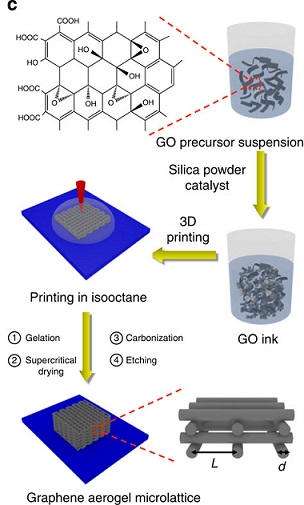Additive manufacturing for the creation of complex three-dimensional (3D) structures has gained significant attention in recent years as a means to manufacture enhanced structural and functional architectures that retain the properties of the materials utilized, for example mechanical strength and thermal properties. 3D printing has emerged as a versatile approach to build such structures from ink formulations incorporating nanomaterials dispersions that have been engineered to provide the necessary properties desired within the physical structure. While 3D printing of a range of nanomaterials has been demonstrated, graphene has recently been explored for the printing of 3D structures of various dimensions having controlled properties. Example applications include printed electronics, biosensors, strain sensors, battery electrodes and separators, or filtration wherein the electrical, physical, chemical, or mechanical properties of the structures are controlled to provide targeted functionality by design. Utilizing processes such as inkjet or nanoimprint lithography, structures have been realized for printed electronics and sensors. More recently, a 3D printing strategy has been demonstrated for the fabrication of 3D graphene aerogels with designed macroscopic architectures, enabling a method to further control the mechanical and surface area properties of complex macroscale structures.

The authors demonstrated 3D printed aerogel microlattices printed having properties that met or exceeded those of bulk aerogel materials. These graphene microlattices, constructed in a log-pile configuration, possess large surface areas, good electrical conductivity, low relative densities and supercompressibility, and are much stiffer than bulk graphene of comparable geometric density. The authors demonstrated that the microstructure and density of the graphene aerogel can be modified by changing the ink formulation, while the mechanical properties of the microlattices can be tuned. Thus work demonstrates a manufacturing method for creating periodic or engineered structures using this novel material which will further expand the range of applications where graphene can be utilized, opening up the possibility to explore the properties and applications of graphene in a self-supporting, structurally tunable and 3D macroscopic form, and could further lead to new types of graphene-based electronics.
Reference: Zhu C, Han YJT, Duoss EB, Golobic AM, Kuntz JD, Spadaccini CM, Worsley MA. Highly Compressible 3D Periodic Graphese Aerogel Microlattices. Nature Communications. 2015; 6: 6962 doi: 10.1038/ncomms7962
